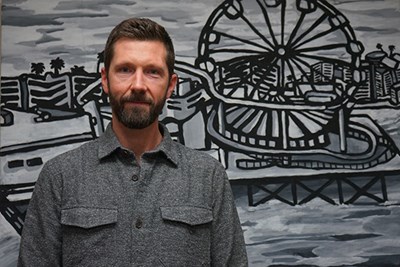Children Learn Better in Their Own Language, Linguistics Professor Says
 Image by Dave Nelson, Cornell
Image by Dave Nelson, Cornell
04/18/2019
By Katharine Webster
Immigrants bring a wealth of languages to the United States, and when teachers value those languages, children learn better – and everybody benefits, an MIT linguistics professor said at the College of Education’s spring symposium.
“Now there’s clear recognition that students are better off when they can maintain or learn a second language,” said Prof. Michel DeGraff. “Language is wealth. We need to find ways to nurture that.”
DeGraff, a native of Haiti, was the keynote speaker at the spring symposium, which focuses on issues in teaching and learning. It was attended by more than 200 students, faculty, alumni and educators from the region.
DeGraff said that dual-language classrooms are one way to put English language learners (ELL) on an equal footing with their classmates and to help native English speakers learn a second language as well.
When teachers have too many “home” languages in a single classroom to offer bilingual or dual-language instruction, they can ask each student or group of students to teach the rest of the class about their language and culture, he said. That engages ELL students, makes them feel valued and enriches the curriculum for all students, as well as better informing the teacher, he said.
“The native speakers can switch roles: They can be teachers instead of students,” he said. “That helps their self-esteem.”
DeGraff heads the MIT-Haiti Initiative, which provides tools and training for Haitian Creole-based, engaged learning in Haiti’s schools. He spoke about his own educational experience, the way that Haitian Creole (or Kreyòl) continues to be incorrectly portrayed as a broken language with a “pidgin” ancestry that makes it inferior to French, and the urgent need to educate all children in their native languages.
In Haiti, both public and parochial schools generally teach in French – a legacy of colonialism, he said. Yet, 95 percent of Haitian children do not speak French at home. The results of educating them in a language they don’t understand have been devastating: Only 10 percent of Haitians who start primary school end up graduating from high school, and only 1 percent have any college education, he said.
“Schools at all levels should teach in Haitian Creole so that students have a good foundation, and then teach French and other useful languages, such as Spanish and English, as second languages,” DeGraff said.
Professors in the College of Education said that there are similar problems in other countries around the globe – and here in the United States. Some 2.3 billion people around the world are educated in a language in which they are not fluent, often a colonial language, said Asst. Prof. Robai Werunga.
After DeGraff’s talk, Prof. Patricia Fontaine moderated a panel of local educators who discussed issues affecting ELL students in Massachusetts.
Through a 2002 ballot initiative, Massachusetts voters abolished effective bilingual education in favor of “sheltered English immersion” for ELL students. Teacher training in sheltered English immersion was implemented hastily and was not required until 2014, Fontaine said.
Children in immigrant families have suffered as a result, Fontaine said. State Department of Education statistics also paint a bleak picture, showing that ELL students – who, under “sheltered English immersion,” must try to learn all of their course content in English – do much worse than their peers on standardized tests and are almost three times as likely to drop out of high school.
“We’re not educating all children,” Fontaine said. “I think we have to target these populations.”
UMass Lowell education faculty have led efforts to better train teachers of non-native English speakers, including through the PETALLs (Preparing Excellent Teachers of All Language Learners) program, a partnership with the Lawrence schools and the state funded by a five-year, $1.6 million U.S. Department of Education grant in 2012.
Under the grant, UMass Lowell provides professional development at every level within UML’s College of Education as well as to teachers, administrators and paraprofessionals in the Lawrence schools, including a graduate certificate in teaching English as a second language. Lesson plans are also available online.
In 2017, the state Legislature passed a law that allows school districts more flexibility to support ELL students, including reintroducing bilingual classrooms.
But in the 15 years that bilingual education was outlawed, the number of ELL students in the state doubled, and it continues to grow. At the same time, the state lost a generation of bilingual teachers. Phala Chea ’94, ’95, ’03, coordinator of English language education for the Lowell schools, where students speak at least 39 different home languages, said that it will not be easy to replace them.
“Now districts can be more flexible, but that would require funding,” Chea said. “In districts like ours, we don’t have funding, we don’t have space, and we don’t have bilingual teachers to hire. When we lost our bilingual teachers, we lost that whole bilingual connection to families, too.”
Lowell, like Lawrence, is trying to develop its own pipeline of teachers and paraprofessionals trained in teaching English as a second language. The Lowell schools are also trying to find ways to encourage more parental and community involvement – and to use the students themselves as a resource, she said.
“We’re trying to become more culturally proficient and responsive in the classroom – to teach students in a way that’s aligned with who they are as individuals,” Chea said.




